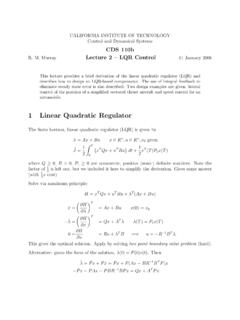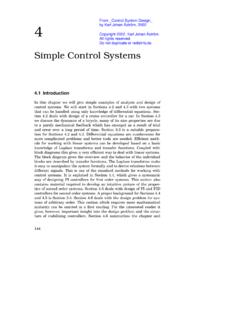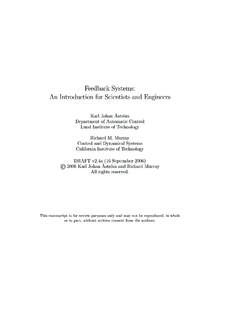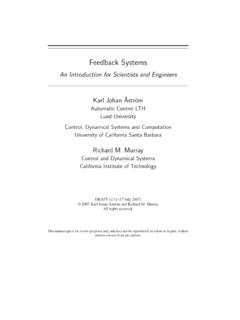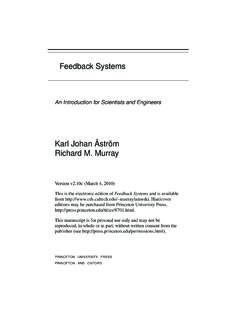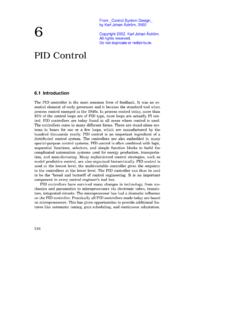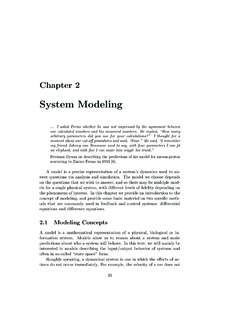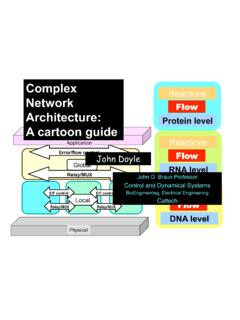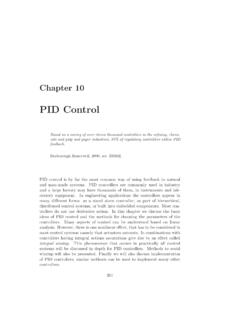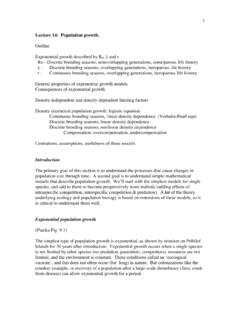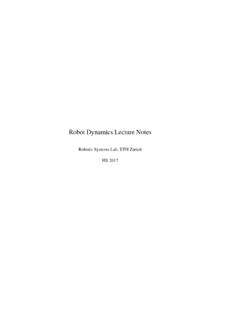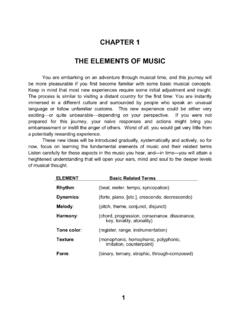Transcription of System Modeling - cds.caltech.edu
1 Asked Fermiwhetherhe wasnotimpressed by theagreementbetweenourcalculated numbersandhismeasured , \Howmanyarbitraryparametersdidyouusefory ourcalculations?"I thoughtforamomentaboutourcut-o procedures andsaid,\Four."Hesaid,\I remembermyfriendJohnnyvonNeumannused to say,withfourparametersI can tanelephant,andwith veI canmakehimwigglehistrunk."FreemanDysonon describingthepredictionsof hismodelformeson-protonscatteringto EnricoFermoin 1953[8].A modelis a preciserepresentationof a System 'sdynamicsusedto an-swer choosedependsonthequestionsthatwe wishto answer,andso theremay be multiplemod-elsfora singlephysicalsystem,withdi erent levelsof delity dependingonthephenomenaof thischapterwe providean introductionto theconceptof Modeling ,andprovidesomebasicmaterialontw o speci cmeth-odsthatarecommonlyusedin feedback andcontrolsystems:di erentialequationsanddi modelis a mathematicalrepresentationof a physical, ustoreasonabouta systemandmakepredictionsaboutwhoa systemwillbehave.
2 In thistext,we willmainlybeinterestedin modelsdescribingtheinput/outputbehavioro f systemsandoftenin so-called\statespace" ,a dynamicalsystemis onein which thee ectsof ac-tionsdonotoccurimmediately. For example,thevelocity of a cardoes not3132 CHAPTER2. SYSTEMMODELING changeimmediatelywhenthegaspedalis pushednordoes thetemperaturein a roomriseinstantaneouslywhenanairconditio neris , a headachedoes notvanishright afteranaspirinis taken,requiringtimeto take e businesssystems,increasedfundingfora developmentprojectdoes notincreaserevenuesin theshortterm,althoughit may dosoin thelongterm(if it was a good investment).
3 Allof theseareexamplesofdynamicalsystems,in which thebehaviorof thesystemevolves viewedin two di erent ways:theinternalviewor describe thein-ternalworkingsof problemwas describingthemotionof thisprob-lemit was naturalto give a completecharacterizationof themotionof carefulanalysisof thee ectsof gravitationalpullandtherelative positionsof theplanetsin a problemwastodescribe electronicampli wasnaturalto viewanampli eras a devicethattransformsinputvoltagesto outputvoltagesanddisregardtheinternaldet ailof theampli theinput/outputviewof di erent viewshave beenamalgamatedin controltheory.
4 Modelsbasedon theinternalviewarecalledinternaldescript ions,statemodels,or whitebox associatedwithnamessuch as externaldescriptions,input/outputmodelso r black box thisbook we theremainderof thissectionwe provideanoverviewof someof thekeyconceptsin theremainderof MechanicsThestudyof dynamicsoriginatedin theattemptstodescribe detailedobservationsof theplanetsby TychoBraheandtheresultsof Keplerwhofoundempiricallythattheorbitsof theplanetscouldbe welldescribedby tryto explainwhy theplanetsmove in ellipsesandhe foundthatthemotioncouldbe explainedby hislaw of theprocesshe alsoinventedcalculusanddi 'sresultwas the rstexampleof theideaof reductionism.
5 Thetriumphsof Newton'smechanicswas theobservationthatthemotionof theplanetscouldbe predictedbasedonthecurrent positionsandvelocitiesof was notnecessaryto know a dynamicalsystemis a collectionof variablesthatcharacterizethemotionof a systemcompletelyforthepurposeof a systemof planetsthestateis simplythepositionsandthevelocitiesof callthesetof commonclassof mathematicalmodelsfordynamicalsystemsis or-dinarydi erentialequations(ODEs).Mathematically, anODEis writtenasdxdt=f(x):( )Herex= (x1;x2;:::;xn)2 Rnis a vectorof realnumbersthatdescribes thecurrent stateof thesystemandequation( )describes therateof changeof thestateas a functionof donotbothertowritethevectorxany di erentlythana willgenerallybeclearfromcontextwhethera variableis a vectoror anordinarydi erentialequationis thevanderPol equa-tion,dx1dt=x1 x31 x2dx2dt=x1;( )which is a modelof thesystemisrepresentedby two realnumbers,x1andx2.
6 Themodel( )gives thevelocity of thestatevectorforeach valueof thestatescanbe described usingeithera timeplotor aphaseplot,bothof which areshownin ,on theleft,showsthevaluesof theindividualstatesas a functionof ,ontheright, showsthevector eldforthesystem,which gives thestatevelocity (representedas anarrow)at everypoint in ,we have superimposedthetracesof someof thestatesfromdi erent a strongintuitive representationof theequationas a vector eldor a secondorder(two states)canbe representedin thisway, it is unfortunatelydi culttovisualizeequationsof dynamicsandstatehave hada profoundin uenceonphi-losophy wheretheyinspiredtheideaof thestateof anaturalsystemis knownat sometime,itsfuturedevelopment is completely34 CHAPTER2.
7 SYSTEMMODELING02468101214161820 1 2 1 2 1 (a)(b) :Illustrationof a statemodelgives therateofchangeof thestateas a functionof thestateas a functionof showstheevolutionof thestatesrelative to each other,withthevelocity of thestatedenotedby theadvent of chaosthe-ory. Asthedevelopment of dynamicscontinuedin the20thcentury, it wasdiscoveredthattherearesimpledynamical systemsthatareextremelysen-sitive to initialconditions,smallperturbationsmay leadto drasticchangesin thebehaviorof chaosalsoresolvedtheproblemof determinism:evenif thesolutionis uniquelydeterminedby theinitialconditions,in practiceit canbe impossibleto make predictionsbecauseofthesensitivity of erentialequation( )is calledanautonomoussystembecausetherearen oexternalin a modelis naturalto useforcelestialmechanics,becauseit is di cultto in uencethemotionof examples,it is usefultomodelthee ectsof externaldisturbancesor to capturethisis to replaceequation( )bydxdt=f(x;u);( )whereurepresents thee ectof externalin ( )is calledaforcedorcontrolled di erentialequation.
8 Themodelimpliesthattherateof changeof thestatecanbe in uencedby theinput,u(t). Addingtheinputmakes themodelricherandallowsnewquestionsto be example, (a)(b) :Illustrationof theinput/outputviewof a gureontheleftshowsa detailedcircuitdiagramforanelectronicamp li er;theoneof theright itsrepresentationas a block canexaminewhatin uenceexternaldisturbanceshave on thetrajectoriesof a ,in thecasewhentheinputvariableis somethingthatcanbe modulatedin a controlledway, we cananalyzewhetherit is possibleto\steer"thesystemfromonepoint in thestatespaceto anotherthroughproper choiceof ElectricalEngineeringA verydi erent viewof dynamicsemergedfromelectricalengineering ,wherethedesignof electronicampli ersledto a systemwas consideredas a devicethattransformedinputsto outputs.
9 As illustratedin a giant tableof usedin many engineeringsystemssinceit allowsus to decomposea probleminto individualcomponents, ,we cantake a complicatedsystemsuch as a radioor a televisionandbreakit downinto manageablepieces,such as thereceiver,demodulator,ampli er, of thesepieceshasa setof inputsandoutputsand,throughproper design,thesecomponents canbe interconnectedto particularlyusefulforthespecialclassofli near, de nelinearity, we let(u1; y1) and(u2; y2)denotetwo input/outputpairs| ,theinputu1producesthe(unique)outputy1|a ndaandbbe systemis linearif (au1+bu2; ay1+by2) is alsoaninput/outputpair;thisis oftencalledtheprincipleof superposition.
10 A systemis time-invariant if theoutputresponsefora36 CHAPTER2. SYSTEMMODELING given inputdoes notdependonwhenthatinputis ,we letu denotea signalobtainedby shiftingthesignaluby unitsof (u; y) is aninput/outputpair,thenthesystemis calledtime-invariantif (ut; yt) is ,applyinganinputnow ortsecondsfromnow willgeneratethesameoutput,justshiftedin time.(Chapter4 providesa much moredetailedanalysisof linearsystems.)Many electricalengineeringsystemscanbe modeledby linear ,time-invariant systemsandhencea largenumber of toolshave beendeveloped example,thestepresponseof a linearsystemdescribestherelationshipbetw eenaninputthatchangesfromzerotoa constantvalueabruptly(a \step"input)
